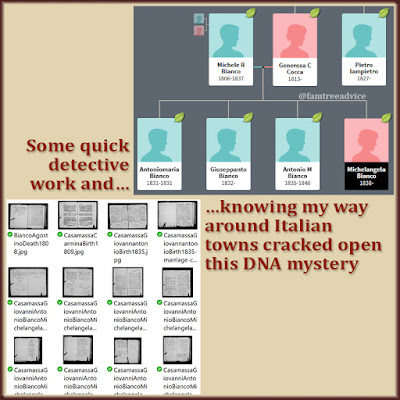There is a way to get a good handle on those tree-less DNA matches.
I bought my DNA test from Ancestry DNA 8 years ago. Lately I've explained a handful of ways to figure out your DNA matches. You'll find them in the DNA section of my Genealogy Lessons page.
Today let's look at one of my new favorite features of Ancestry DNA: shared matches.
I've uploaded my raw DNA file to other sites, including GEDmatch, Family Tree DNA, 23 and Me, and My Heritage. But Ancestry gives me the best tools to use.
I imagine I'd get more tools from the other websites if I had a paid membership! I did pay a one-time fee to Family Tree DNA, and I see they do have a "Matches in Common With" feature. Check your testing site for something like what I describe below.
I love the Shared Matches feature on Ancestry. Keep in mind that this is extra important for those DNA matches who haven't attached a usable family tree.
Ancestry lets you add each DNA match to groups you create. Once you do, that match gets one or more colorful dots attached to their listing. I use a green got to signify that I've figured this person out. So I'll scroll down to find a DNA match without a green dot. I want to focus on my mother's side of the family. My father's side has a gazillion matches, all coming from one ancestral town! My mother's side has far less matches.
 |
| When your DNA match offers little or no clues, don't forget to look at your shared matches. |
My 1st match on my mother's side without a green dot has a last name I know. It starts with a V. This name is from a town tied to my maternal grandmother's family. It's called Pastene, and it's very small.
His tree is as useless as it gets. It has 1 private person. Him! When I click Shared Matches on Ancestry, I see that besides my mother, we share only 4 DNA matches. I recognize 2 of our shared matches as being descendants of that same last name. I know this because I've corresponded with them and explored one of their trees.
Another shared match has my grandmother's maiden name, so I know his roots are also in Pastene. I'll add a note to this match's profile that says he's a V from Pastene.
But I can keep going. I clicked the match with Grandma's maiden name. He also has no family tree, but I can look at his shared matches. This list includes everyone from the previous shared matches list, and several more.
I see one match who I know had a grandmother with my Grandma's maiden name. I see another match whose handle appears to be an abbreviation of that maiden name. Her shared matches support that idea.
One other match has a last name I know from a different, but connected town. You see, my 2nd great grandfather was from Pastene, but he married a girl from nearby Santa Paolina. This match has a name that's prevalent in Santa Paolina to this day.
Following this method, I can add notes to the profiles of unknown matches. The notes can include last names I know and towns. Over time, these notes will help me see how different matches may fit together.
I can continue to click interesting shared matches and view our shared matches. Here's a person with a decent tree of 243 people. On both the mother's and the father's side of this tree, I see last names from Santa Paolina. Lately I've been reviewing my downloaded vital records from Santa Paolina. I'm getting very familiar with the town's names as I change the file name of each document image. For each image, I'm adding the person named on the document and their father's first name.
I know I can find vital records for this DNA match's grandparents and generations before them. This is a match I can figure out!
 |
| Make notes and use groups to leave yourself research breadcrumbs. |
When I figure them out, and work them into my family tree, I'll have strengthened my ties to our shared DNA matches. More "common names" will appear in our trees.
If your DNA website lets you add categories or notes to your matches, do it. (Do this offline in a spreadsheet, if you must.) Leave yourself these useful breadcrumbs. If you know the general branch a match should fit into, note that. If they have last names you know, notes them.
It's impossible to count our thousands upon thousands of DNA matches. But categorizing many of them, and figuring out those you can, can help you get to the result you want. And that is, fewer empty branches on your family tree.







